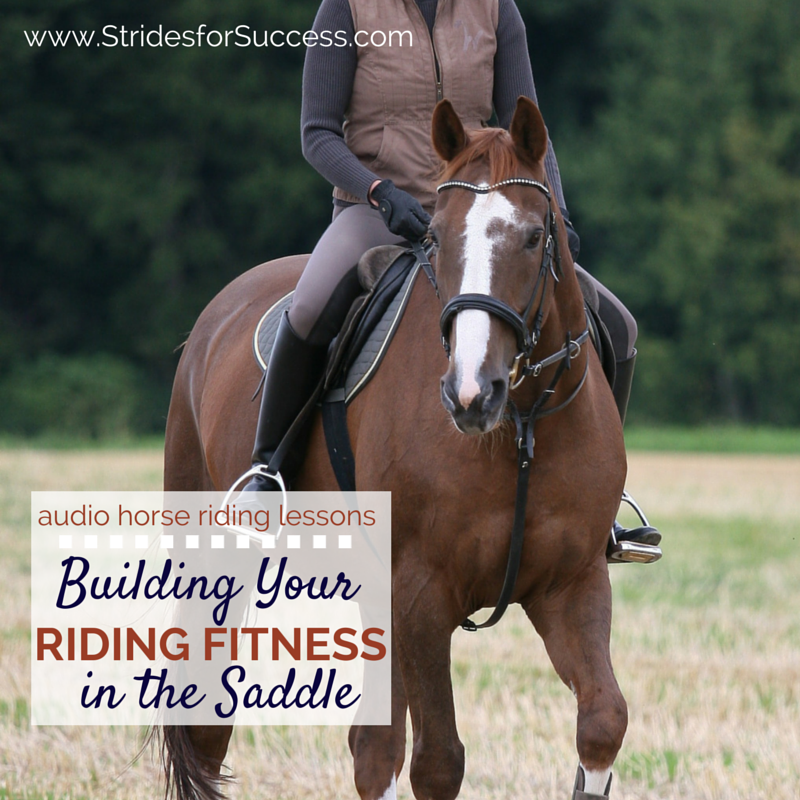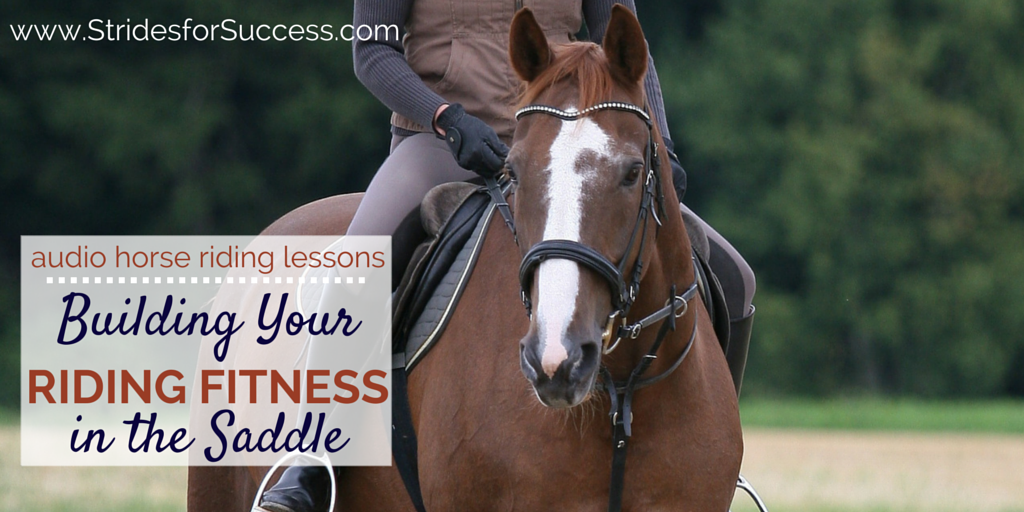Do you find yourself huffing and puffing after a few strides of canter? Have you been riding less recently and find that now your back in the saddle, you’re less effective than before? Are you spending hours schooling your horse but seeing little to no difference in his way of going…
It often amazes me how much time, effort, planning, and work riders put into conditioning and increasing the fitness levels of their horses. And yet completely fail to invest even a little of that towards their own fitness levels!
Contrary to popular belief, riding is a team sport… You and your horse! So it leads us to the fact that, as with any team sports, it is essential that all members of the team are doing their best to contribute to the team’s success.
How Will Increasing Your Riding Fitness Help?
Increasing your level of fitness with regard to horse riding has numerous positive consequences on your overall performance in the saddle.
You will find that you become increasingly better able to communicate with your horse. And your aids will become easier to apply and clearer for your horse to understand
You will also develop a more independent seat as your core strength grows. This, again, will increase your effectiveness in the saddle. Another huge positive result is that any stiffness and rigidness that you are holding within your body will begin to dissipate as you both physically and mentally begin to have more faith in your abilities. And, of course, your stamina levels will increase too…
Meaning you can enjoy your more canters and for longer periods!

Setting Yourself Up for Success
Before we go any further, it is important that in order to ride these exercises, you are on a trustworthy horse. I also strongly suggest riding in a safe or enclosed area. A young horse or a strange place is not the best time to try out new exercises. Especially ones that will test your balance and strength!
If your horse tends to ‘wander’ when you are not directing him, perhaps creating a small chute in the arena using jumping uprights and poles will help. This will allow you to focus on what you are doing. And ensure that you get the most out of the exercises.
These exercises are also excellent to do while warming up or cooling your horse down. It is you that must do the work, not your horse!
Getting Started; Your Position
I suggest beginning with giving your position a quick once over, and check that you are in a correct alignment. Simply put, you’re sitting correctly in the saddle.
Take your feet out of the stirrups, and start with some light stretches.
After this, you can begin the first exercise. This involves drawing up your knees, one at a time, to your horse’s withers. While you are doing this, pay close attention that your upper body remains straight and upright. It is tempting to ‘curl’ your lower back and shoulders when performing this exercise but don’t.
Focus on identifying your legs individually and then lifting them using only your leg to do so.
Use your core muscles to help you keep your balance while your knee is raised. Hold it for a few seconds and then gently replace your leg and repeat on the other leg. If you are feeling brave, you can raise both knees at the same time (jockey style), however again, make sure you are not crouching with your back and shoulders.
Legs & Core Strength & Fitness
This is a super exercise not only for your legs and core muscles, but also to help you make sure you are indeed sitting on your seat bones. It also helps to relax the pelvis which will help with the other exercises and your riding in general.
If you find that you are feeling unbalanced or concerned about ‘tipping over’ out of the saddle, rather ask your horse to halt and, having someone hold him still if necessary, complete the exercises while your horse is standing still.
With your feet still out of your stirrups, begin stretching your legs down nice and long. Then one at a time lift your leg away from your horse’s side. There should be daylight between your leg and the saddle.
Try to lift your lower and upper leg. But, make sure that while you lift, you are not leaning your body weight to the opposite side to lift your leg for you!
The lift must come from the muscles on the outside of your hips and the sides of your torso. Pay attention that your body remains upright and not collapsing down.
After you have managed to lift each leg individually, you can then try lifting both legs together. Again, it is tempting to lean forward and curl your upper body. But try to continue carrying yourself as you perform the exercise.

Introducing Sitting Trot
You can also incorporate some sitting trot work into this initial warm-up. Pay attention that you are keeping your pelvis and thighs open. Not gripping up, but rather stretching your leg down around your horse.
Focus on allowing your lower body to move with your horse in almost a back and forward motion rather than an up and down motion. You can also work some circles into your school movements, all the while maintaining a good basic position.
Posting in the Walk
Another great exercise you can work on to increase your fitness levels is posting in the walk. Obviously you will need to take your stirrups back for this exercise, and once your feet are in… Yes, you guessed it; Check your position!
Posting or performing the up-down movement from the rising trot while walking can be quite a challenge. This is due to the fact that your horse’s natural momentum in the trot is not there to help you.
Keep in mind that when you post or stand, you are doing so on your heel, not your toes.
Also, that your lower leg remains underneath you. Many riders will try to use their upper bodies to ‘pull’ themselves up and whether or not they use the reins, this is incorrect. Rather think of pushing yourself up using your legs.
Once up, it will require your core muscles to help you maintain your balance and lower yourself back into the saddle with the sufficient ‘grace’ that is required!! Do not allow your body to fall back into the saddle as you come down as it will be uncomfortable, and may even hurt, your horse’s back.
Standing in the Stirrups
Developing on from the highest point of this exercise, you can begin to ‘stand’ in your stirrups as you walk around the arena. When standing, keep in mind that your knees will have to keep a slight bend in them in order to help you absorb the movement of your horse underneath you.
It is, again, worth mentioning that you should not use your reins for support and balance while performing this exercise…
Rather hold a martingale strap or even a stirrup leather that is secured around your horse’s neck for support if necessary. Also, make sure you do not collapse down into the saddle when you have finished. Gently lower yourself into the saddle…
Or remain ‘standing’ in to the trot and even the canter. This will use your legs and also your core muscles to achieve it correctly. Start off slow and for short bursts, working over time to longer periods at faster paces.
Additional Exercises to Increase Fitness
Other exercises you can use, which we cover step by step in this week’s Daily Strides Premium are changing the variation of your posting while trotting. Rather than the usual up, down, up, down, up, down; rather begin sitting or posting/rising for an extra beat.
This would look like up, up, down, up, up, down, up, up, down, or the other way around; down, down up, down, down, up.
All variations of this will firstly create mindfulness around what you are doing while you post or rise. And, secondly, require your core muscles to shift from sitting to the rising trot more frequently than your normal up, down, up, down does.
You can also work in the two-point seat…
In fact, this is a great way to initially test your riding fitness levels by seeing how long you can hold the position, independently, before sitting down. Work at increasing this time period on a weekly basis. Make sure, again, that the weight is down in your heel and that your back is straight, not rounded or arched.
Your Riding Fitness Is Your Responsibility
As you can see there are numerous ways to incorporate a mini-workout into your everyday riding and schooling.
Very often with adult riders, time is the greatest challenge when it comes to fitness, however as before, all these exercises can be performed while you are warming up and cooling down.
Happy Riding
Lorna
Additional Resources for Equestrians
-
-
- Improving Your Riding with Your Light Seat
- The Direct Relationship Between Your Fitness and Your Riding
- [Blog Post] Exercises in the Saddle to Improve Your Coordination
- Equestrian Fitness Challenge
- Lunging for Riding Digital Course
- Online community for equestrians working on their mindset & fitness
- Online Community for equestrians focusing on re-schooling horses (and ex-racehorses)
- The Daily Strides Podcast on iTunes
- The Daily Strides Podcast on Stitcher Radio
-

